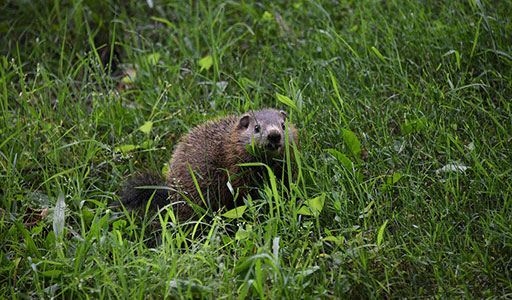Groundhog Removal
Do you need to get rid of groundhogs? We can help!

Groundhog Removal Strategies
If you have noticed groundhogs destroying your property with their constant burrowing and grass eating, then it may be time to call the experts at Trutech for some help. Our team of licensed specialists have the skills and tools necessary to conduct a humane groundhog removal or control of your property. At Trutech, we care about all animals, big or small. We even love the animals that burrow underneath the ground.
Our humane wildlife removal and management services are the best way to keep your property safe from the potentially destructive actions of animals like groundhogs. Here at Trutech, we are here to help you gain back your peace of mind with a groundhog free yard. Don’t wait until groundhogs have destroyed your lawn to seek help. Trust our team of experts at Trutech for all of your groundhog removal and groundhog control needs by calling today!
Groundhog Problem

Signs a Groundhog is on Your Property
Groundhogs (or woodchucks) are large rodents that are found throughout much of the eastern United States and into parts of Canada and Alaska. Groundhogs are typically around 5-10 lbs in weight and anywhere from 15 to 30 inches long. When they see, smell, or hear an observer, groundhogs may seek refuge in one of their underground burrows. Groundhogs are herbivores, eating mostly grass, berries, and clovers.

Dangers of Groundhog Infestation
The biggest issues caused by groundhogs result from their feeding habits. Farmers and gardeners alike detest these pests, as they eat any vegetation near their den sites. Groundhog holes can also be detrimental, causing injury to livestock and damaging equipment. Additionally, burrow systems may affect building foundations.
Humane Groundhog Removal & Control Strategies

Entry into property
Groundhogs, for the most part, do not enter homes. Nevertheless, the pests do burrow under manmade structures and can cause numerous problems with their dens.

Trapping & Removal
Groundhogs are known to carry various parasites, fleas, and ticks in addition to diseases harmful to both humans and pets. While not naturally aggressive, these pests can attack when cornered or trapped. To ensure safety, contact Trutech pest specialists for all groundhog removal needs.

Prevention & Exclusion
Homeowners can build fences around their gardens to keep the pests out. These fences should be tall and buried at least a foot underground to be effective. Placing gardens and ornamental plants away from wooded areas on properties can also keep groundhogs away.
Frequently Asked Questions
The groundhog has a broad, flat head with small eyes and ears. These pests are known for hibernating through the winter. Therefore, they are most destructive in early fall because they eat almost constantly to pack on fat.
Groundhogs cause damage to gardens and decorative plants when they feed. Since they gnaw to trim their long front teeth, they can also destroy small trees, shrubs, or bushes. When burrowing, they make lawns unsightly and uneven, creating hazards for humans and impacting lawn care.
Exclusion is the best deterrent for groundhogs. There are several methods that can be used to keep groundhogs away:
- Fencing – Effective fences are three feet high, made of heavy wire or mesh, and buried a foot underground. In addition, fences should be set at an angle to prevent climbing.
- Wiring – Welded wire panels can also be buried to cover abandoned burrows and prevent future use.
- Habitat alteration – Remove what attracts groundhogs to yards, including underbrush and high grass that can be used as hiding places.
- Harassment and frightening – Put foul-smelling soiled kitty litter or hot peppers near burrows. Property owners can also destroy tunnels or use balloons attached to string to mimic human activity.
While these are all useful tools, groundhogs are smart and resourceful, so they can often outwit humans.
While repellents and toxicants are not available for private use, there are some fumigants on the market. These are usually toxic gasses, like carbon monoxide cartridges, that are pumped into burrows. However, these are highly dangerous, and states have laws regulating their use.
Groundhog diseases may be transmitted to humans or pets through bites. Rabies is a serious condition that, while more common in pets and wildlife, can still cause serious health problems and even be deadly for humans if not promptly treated.
Groundhog diseases can also be transmitted indirectly through parasites found in the pests’ fur. For example, the aptly named groundhog tick is able to attach to pets, especially dogs who are fond of chasing groundhogs, and may eventually infect people. Groundhog ticks transmit Powassan disease, symptoms of which include fever, headache, and vomiting. The pests may also carry American dog ticks, which are major carriers of Lyme disease and Rocky Mountain spotted fever.
Groundhog holes in yards and gardens are typically easy to spot. Nearly a foot in diameter, they can be distinguished from most other holes created by wildlife due to the large mounds of excavated soil that sit nearby.
The main entrance is typically the most noticeable, as other openings tend to be well-hidden and can be more difficult to locate.
Groundhog holes lead to a network of chambers and tunnels with multiple entrances. These burrows can extend up to 40 feet!
Other animals have been known to use a groundhog burrow. Raccoons, skunks, and opossums will use a burrow during the winter. Abandoned groundhog burrows can attract chipmunks, cottontail rabbits, voles, weasels, snakes, foxes and coyotes.
These pests are known to make various noises that can distinguish them from other pests:
- When angry or cornered, groundhogs may chatter their teeth.
- The pests make a low warble that sounds like “chuck-chuck” when startled.
- These animals are also called whistle pigs due to the shrill whistle they make to alert other groundhogs of nearby predators.
When the pests make their way into yards, residents may employ groundhog traps. Humane live traps can be effective if set correctly, though there are several factors to consider:
- Traps should be placed near burrow entrances or where damage is most obvious.
- Cover traps with grass or dark canvas to make them more inviting to groundhogs.
- Baiting traps with lettuce, peas, or apple slices can entice the pests to enter.
Though groundhog traps may help, capturing the pests leads to other issues. Trapped animals must be removed, though simply releasing them elsewhere relocates rather than solves the problem. Additionally, catching diseased pests could expose people to rabies. Body-grip traps are also available, though their set-up can be complicated and still requires trappers to handle pest remains.
Any animal feces found in the yard are unlikely to belong to groundhogs. These tidy animals actually dig special chambers for waste in their underground burrows.
As a result, people often blame woodchucks for messes that were actually created by other tunneling pests. Skunks, prairie dogs, and badgers are all known to dig holes in yards as well as leave their droppings for homeowners to find.


